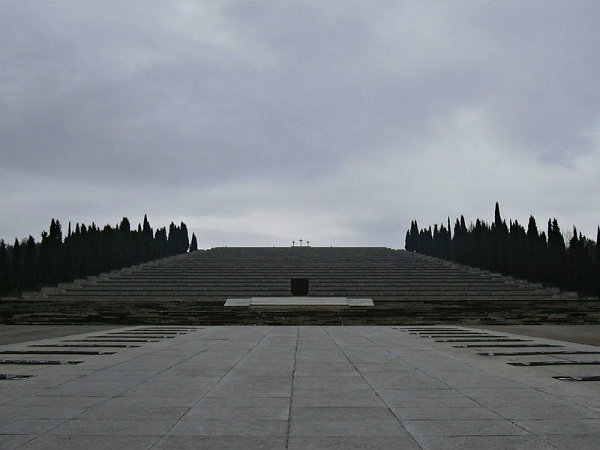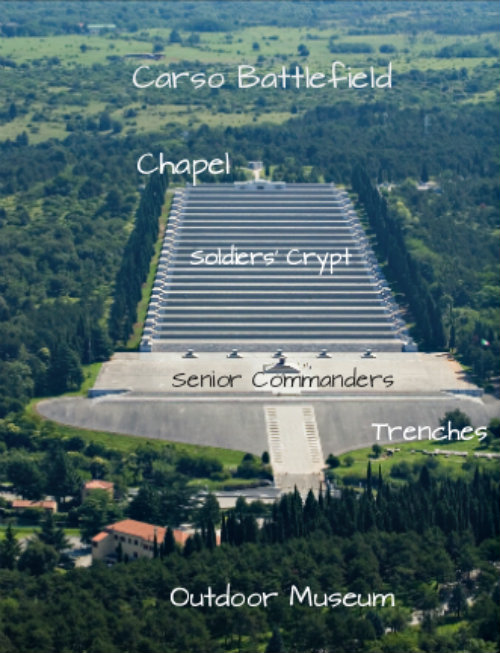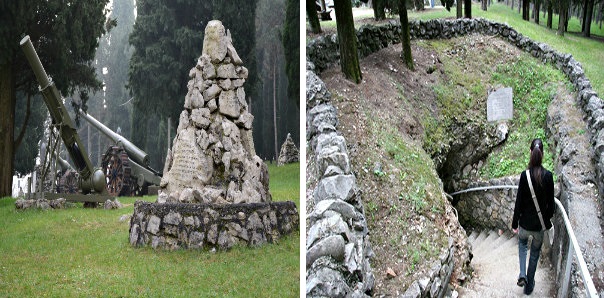If you are visiting Italy this year, take time to go to Italy’s largest war memorial, the the Military Sacrarium Redipuglia, and take time to reflect on the bitter aftermath of the Great War which happened a century ago.
There is more to the impressive historical display located just outside Redipulgia, Italy — it is a pulsing bile reminder of an event which happened one hundred years ago, the battle we know now as the Great War or WWI. Just about an hour’s drive from the Aviano Air Base, the Military Sacrarium Redipuglia is filled with symbolism connected to “the war to end all wars”. The steps leading to the memorial epitomizes the grim battle WWI servicemen had to go through and endure just so they could maintain command they had held at the summit of the mountain. Plaques found throughout the memorial are inscribed with the names of places thought-out to be where the worst fighting were fought.
The military shrine itself, which was completed way back in 1938, is believed to be the biggest WWI shrine in whole Italy. The steps which lead up through the mountainside to the Military Sacrarium Redipuglia hold close to the edges of some twenty-two terraces. Contained in these terraces are the remains of over 100,000 soldiers killed during the First World War.
near the memorial site’s bottom lies the tomb of the Duke of Aosta. Furthermore, the duke’s resting place leads the tombs of five other generals. Walls placed directly behind these are filled with the names of about 40,000 soldiers. Another two tombs flank a chapel found at the top of the terrace of the Military Sacrarium Redipuglia. The chapel and these tombs honor the more than 60,000 unknown WWI soldiers who perished in the war. And finally, at the base of the Military Sacrarium Redipuglia are the hardened century-old trenches, the ones that were used to defend the place from the enemies.
If you go within the bunkers, the view you’ll get of the shrine is both dispiriting and inspiring. Dispiriting in the sense that so many lives were lost but at the same time inspiring as so many individuals during those times were willing to give up their lives for the cause of the war and so many willing to make the memorial come into fruition in remembrance of the sacrifices these people made.
The church bells give a loud and clear ring throughout the war memorial. An observatory can be found just behind the religious edifice which, by the way, is still used on occasions. The observatory holds a bronze map of the region which surrounds the Military Sacrarium Redipuglia.
Down the memorial’s terraces and across the street is the House of the Third Army so named after the Third Army which the Duke of Aosta commanded during the war. The house contains a free museum where one can find images and artifacts dating back to the the early 1900s. There are English pamphlets which will serve as your guide through the museum. Among the items displayed within this free museum are weapons, uniforms dating back to the WWI-era and even a machine-gun bunker. One can also find awards and citations given to soldiers among the displays.
The original memorial can still be found just near the museum. This holds the remains of 30,000 soldiers. Cannons, artillery rounds and benches can be found scattered with the clusters of Cypress trees throughout the memorial. Its centerpiece is an ancient Roman column which came from the city of Aquileia. Spread out through the tranquil memorial site are recreated tombstones with Italian poetry inscribed on them as well as the equipment and tools used by the soldiers during the war.
The museum in the Military Sacrarium Redipuglia is open from 9 AM to noon as well as from 2 to 5 PM. It is closed on Mondays and is open on Sundays only from April to September.
Meanwhile, admission is free in the the open air museum, Remembrance Park as well as the enclosed museum.


